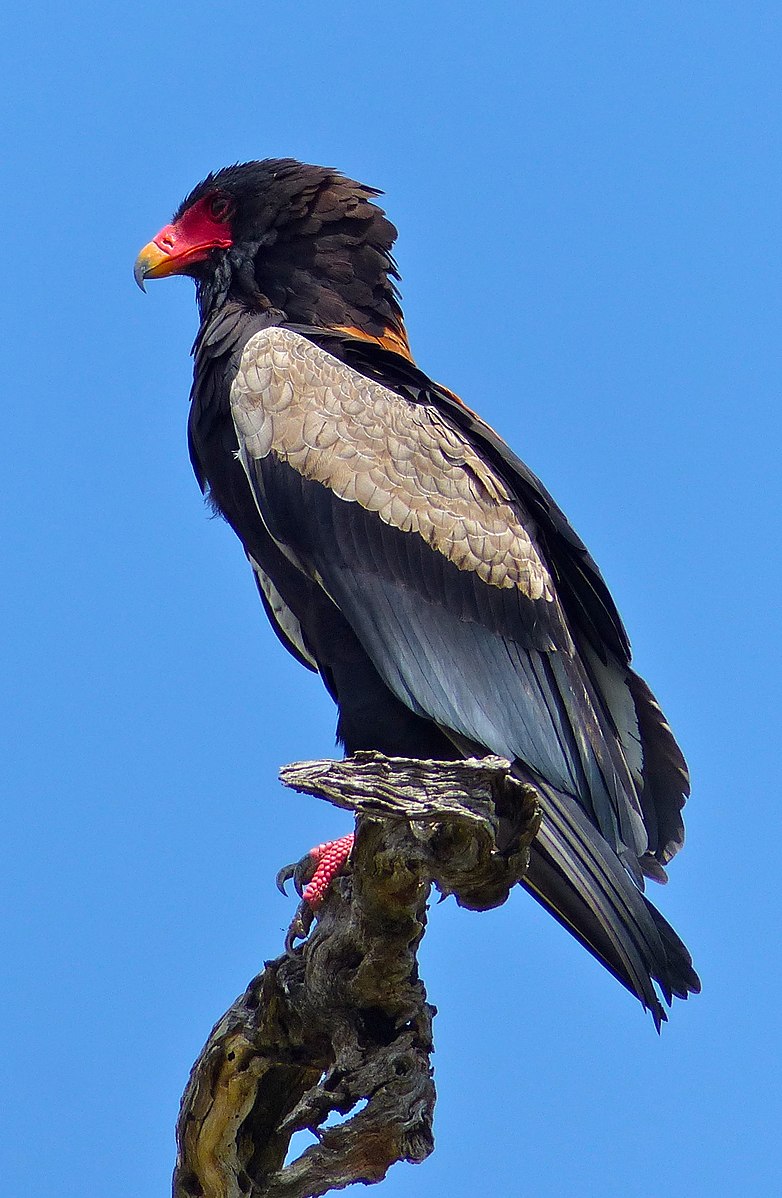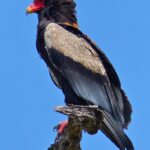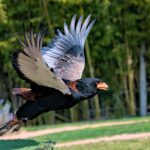The Bateleur Eagle (Terathopius ecaudatus) is a striking bird of prey native to broad areas of Sub-Saharan Africa and scarcely up into Arabia. It is characterized by its pitch-black feathers, white under the wings, bright red face and legs, and black beak. Unlike most creatures, female Bateleur eagles are larger than males.
The Reproduction and Nesting of Bateleur Eagles
The life cycle of the Bateleur Eagle begins with reproduction. The female lays a single egg in a nest that sits in a large tree, which offers protection. Mother incubates the egg while father collects food and sticks for the nest. After an incubation period of 52-59 days, the baby Bateleur eagle hatches.
The Hatchling and Early Development
 Image source: Bateleur Eagle By Bernard DUPONT
Image source: Bateleur Eagle By Bernard DUPONT
The hatchling is highly altricial and very feeble at first, being unable to lift its own heavy head and possesses a deeply wrinkled cere. The small eaglet is initially covered in creamy down with a chocolate-brown patch behind the eye that matches the rest of the body. At about 2 weeks, the young eaglet becomes somewhat more active and the down develops a patchy appearance. At 3 weeks, the eaglet has a downy white head but the down color above is dark brown, with the first brown feathers sprouting on back of head, secondaries and scapulars.
Feather Growth and Fledgling Stage
By 4 weeks, they no longer have any white down and brown feathers grow especially the back and wing ones; while a week later, the feathers continue emerge and the secondaries outgrow the primaries. Thence at 7 weeks, the feathering of the foreparts occurs rapidly, being complete by 35 days, but the wing and tail feathers are still growing, the last remaining down being on underwing coverts. The young eaglet resembles those of snake eagles in appearance and feather growth pattern, particularly the retarded growth of the primary feathers, and in general coloring become greyer as the eaglet ages. The nestling may first stand at about 5 weeks as well as engage in wing-flapping. Pre-independence juveniles may perch or lie in prone position before they can fly well. The stage at which the young first feeds itself is dictated by what prey is brought; if it is large, the parents will feed the young to 40 days, but small fragments will be eaten unaided by the downy young. Around 6 weeks is when the eaglet can typically feed itself for the first time. At 9 weeks, eaglet bateleurs have been recorded doing effective threat displays against humans. Fledgling typically occurs around 90-125 days with reported extremes at as little as 93 to as much as 194 days.
Sunning Behavior and Hunting Habits
Bateleurs often sun. They stand upright and hold their wings straight out to the sides and tipped vertically, a classic ‘phoenix’ pose, and they turn to follow the sun. Bateleurs will stand on the ground with their wings spread, exposing the feathers to direct sunlight, warming the oils in the feathers. The bird will then spread the oils with its beak to improve its aerodynamics.
Bateleur eagles pair for life and stay in the same nest for several years. Unpaired adults can sometimes be seen near a nest site. This bird is not rejected by the mating pair and does not help with nesting. The bateleur is most commonly seen in rapid, direct flight which is its preferred method of hunting. Birds may cover 300 miles in up to an eight-hour-long daily searches for food. Due to the extensive area covered each day, the number of eagles in the wild is easily over-estimated in its native sub-Saharan region of Africa, but their numbers in parts of their range are declining.
References:
– https://www.krugerpark.co.za/africa_bateleur_eagle.html
– https://en.wikipedia.org/wiki/Bateleur
– https://ielc.libguides.com/sdzg/factsheets/bateleur


